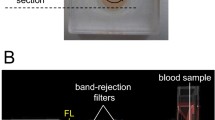Summary
The aim of the present study was to investigate chemiluminescence (CL) of stimulated peripheral phagocytic cells (PC, i.e. granulocytes and monocytes) in patients with malignant disease at various stages. As a first step the zymosan-induced and luminol-amplified CL was determined in diluted whole blood samples from healthy volunteers. A characteristic daytime dependence of the CL activity was observed in six volunteers which had to be taken into account for blood sampling. The detectable CL was demonstrated to depend on the number of erythrocytes in the assay, but correction for this is not necessary for clinical investigation. The specific CL activity (activity related to 103 PC, was significantly but identically increased both in 1) patients with acute inflammatory disease and 2) in patients with carcinoma. The total CL activity (activity/µl whole blood), however, was significantly increased in patients with acute inflammation as compared to the tumour group. This greatly reflects the leucocytosis of patients with acute inflammation. In a small number of patients with benign and malignant disease the CL of PC was measured both pre- and postoperatively. Operations in benign disease and palliative operations in malignancy did not influence the CL activity. In contrast, CL activity returned to normal after clinical cure by radical tumour resection.
Similar content being viewed by others
References
Allen RC, Stjernholm RL, Steele RH (1972) Evidence for the generation of an electronic excitation state(s) in human polymorphonuclear leukocytes and its participation in bactericidal activity. Biochem Biophys Res Commun 47:679–684
Babior BM (1978) Oxygen-dependent microbial killing by phagocytes. N Engl J Med 258:659–668, 731–725
Badwey JA, Karnovsky ML (1980) Active oxygen species and the functions of phagocytic leukocytes. Ann Rev Biochem 49:695–726
Block LH, Lüthy R, Siegenthaler W (1980) Oxydativer Metabolismus von Phagozyten: Physikochemische Grundlagen und klinische Relevanz. Klin Wochenschr 58:1271–1281
Clark RA, Klebanoff SJ (1977) Studies on the mechanism of antibody-dependent polymorphonuclear leukocyte-mediated cytotoxicity. J Immunol 119:1413–1418
Dudrick SJ, Copeland EM, Daly JM (1980) Cancer and immunocompetence. Acta Chir Scand [Suppl] 98:146–150
Fischer H, Kato T, Wokalek H, Ernst M, Eggert H, Rietschel ET (1980) Measurement of granulocyte and platelet chemiluminescence in small samples of whole blood. In: DeLuca M, McElroy P (eds) Proceedings of the 2nd International Symposion on bioluminescence and chemiluminescence. Academic Press, New York
Fischer H, Staudinger HJ (1981) Chemilumineszenz, ein Indikator für Zellaktivierung? Klin Wochenschr 59:199–201
Floersheim GL (1978) Immunsuppression als Begleitwirkung. Schweiz Med Wochenschr 108:1449–1460
Hafemann DG, Zoltan JL (1979) Polymorphonuclear leucocyte-mediated, antibody-dependent, cellular cyto-toxicity against tumor cells: dependence on oxygen and the respiratory burst. J Immunol 123:55–62
Kato T, Wokalek H, Schöpf E, Eggert H, Ernst M, Rietschel ET, Fischer H (1981) Measurement of chemiluminescence in freshly drawn human blood. I. Role of granulocytes, platelets and plasma factors in zymosan-induced chemiluminescence. Klin Wochenschr 59:203–211
Kahan BD (1980) Surgical immunology: Identification of immune elements and opportunities for intervention. Adv Surg 14:151–230
Klassen DK, Sagone AL (1980) Evidence for both oxygen and non-oxygen dependent mechanisms of antibody sensitized target cell lysis by human monocytes. Blood 56:895–992
McKhann CF, Slade MS, Gunnarson A, Burk MW (1975) Lymphocyte responsiveness in cancer and transplantation. Transplant Proc 7:287–290
Nelson RD, Mills EL, Sommons RL, Quie PG (1976) Chemiluminescence response of phagocytizing human monocytes. Infect Immun 14:129–134
Scornik JC, Klein PA (1978) Antibody-dependent lysis of tumor cells in vivo. I. Early lysis of tumor cells. J Natl Cancer Inst 61:1143–1154
Soberman RJ, Karnovsky ML (1981) Biochemical properties of activated macrophages. Lymphokines 3:11–31
Wokalek H, Kato T, Schöpf E, Eggert H, Rietschel ET, Ernst M, Fischer H (1980) Erste Erfahrungen mit der Chemilumineszenz-Messung in humanem Vollblut. Aktuel Dermatol 6
Author information
Authors and Affiliations
Rights and permissions
About this article
Cite this article
Heberer, M., Ernst, M., Dürig, M. et al. Measurement of chemiluminescence in freshly drawn human blood. Klin Wochenschr 60, 1443–1448 (1982). https://doi.org/10.1007/BF01720991
Received:
Accepted:
Issue Date:
DOI: https://doi.org/10.1007/BF01720991



